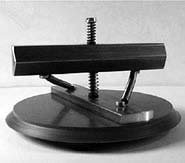
Two cricket-like creatures establish new insect group.
The first new order of insects to be discovered for more than 80 years has emerged from the mountains of Namibia. The order’s first official members are two creatures about 2 cm long that look a bit like a cross between a cricket and a stick insect 1 .
The group, called Mantophasmatodea, joins the other 30 or so insect orders such as beetles, flies and termites. “If it was in mammals it’d be like

Between now and Saturday, 20 April, you can follow via the Internet the progress of the new-found Comet SOHO-422. Usually, comets seen by the SOHO spacecraft quickly burn up in the Sun’s hot atmosphere. This one won’t, so there is still time to monitor its progress.
Like most of the hundreds of comets found with the ESA-NASA sun-watching spacecraft, SOHO-422 was first noticed by an amateur astronomer. Pictures from SOHO are made available, freely and rapidly, on the Internet. Peop

P3P gives people more control over use of personal information on the Web
The World Wide Web Consortium (W3C) has issued the Platform for Privacy Preferences (P3P) 1.0 as a W3C Recommendation, representing cross-industry agreement on an XML-based language for expressing Web site privacy policies. Declaring P3P a W3C Recommendation indicates that it is a stable document, contributes to Web interoperability, and has been reviewed by the W3C Membership, who favor its widespread adoption.

Random vibrations can generate rotation.
A simple top converts foghorn noise to one-way spin. The device raises the hope that useful energy could be collected from ambient sounds. Normally, random vibrations, which physicists and engineers call noise, produce useless random motion. You can’t move a cart from A to B by shoving it randomly in every direction.
But in the new device, made by Yaroslav Zolotaryuk of the Technical University of Denmark in Lyngby and colleagues

Chemists put biological catalysts to work in clean industrial solvents.
In a move towards cleaner chemical processing, researchers in Spain and France have worked out how to use enzymes as catalysts using two ’green’ solvents: one to dissolve the enzyme, the other to dissolve the materials it transforms.
In some industrial processes chemists have replaced polluting organic solvents, such as chlorine and benzene, with supercritical carbon dioxide. This is the liquid

Research chemists have a found a class of synthetic molecules that could quite literally act as a key which could lock away sections of DNA into a closely wound coil preventing proteins from interacting with particular sections of DNA code. By locking up the DNA in this way scientists could stop particular sequences of DNA from activating biological changes that doctors or scientists would rather avoid, or wish to regulate closely.
Until now researchers trying to devise synthetic molecules t

– new calculation confirms standard model of particle physics. Contribution of hadronic vacuum polarization determined with unprecedented accuracy. The magnetic moment of the muon is an important precision parameter for…
Technique may prevent formation of unwanted waves that siphon off needed energy. Heating plasma to the ultra-high temperatures needed for fusion reactions requires more than turning the dial on a…

An international team of astronomers, led by researchers from the Astronomical Observatory of the University of Warsaw, have identified a new class of cosmic X-ray sources. The findings have been…

How deubiquitinases USP53 and USP54 cleave long polyubiquitin chains and how the former is linked to liver disease in children. Deubiquitinases (DUBs) are enzymes used by cells to trim protein…

Conceptual blueprint to analyze experimental catalyst data. Machine learning (ML) models have recently become popular in the field of heterogeneous catalyst design. The inherent complexity of the interactions between catalyst…

Antibody that Neutralizes Inhibitory Factors Involved in Nerve Regeneration Leads to Enhanced Motor Function after Acute Spinal Cord Injury. Researchers at 13 clinics in Germany, Switzerland, the Czech Republic and…

How simulations help manufacturing of modern displays. Modern materials must be recyclable and sustainable. Consumer electronics is no exception, with organic light-emitting diodes (OLEDs) taking over modern televisions and portable…

“Neurons that fire together, wire together” describes the neural plasticity seen in human brains, but neurons grown in a dish don’t seem to follow these rules. Neurons that are cultured…

The quest for sustainable energy solutions has been a major focus of scientific research for decades. Solar energy, a clean and renewable source, has emerged as a promising alternative to…

With a processing speed a billion times faster than nature, chip-based laser neuron could help advance AI tasks such as pattern recognition and sequence prediction. Researchers have developed a laser-based…

New technology could remotely identify various types of plastics, offering a valuable tool for future monitoring and analysis of oceanic plastic pollution. Researchers have developed a new hyperspectral Raman imaging…

Artificial Intelligence (AI) has established a strong presence across industries, large and small. The “VoBaKI” research project has empowered small and medium-sized enterprises (SMEs) with an innovative tool to independently…